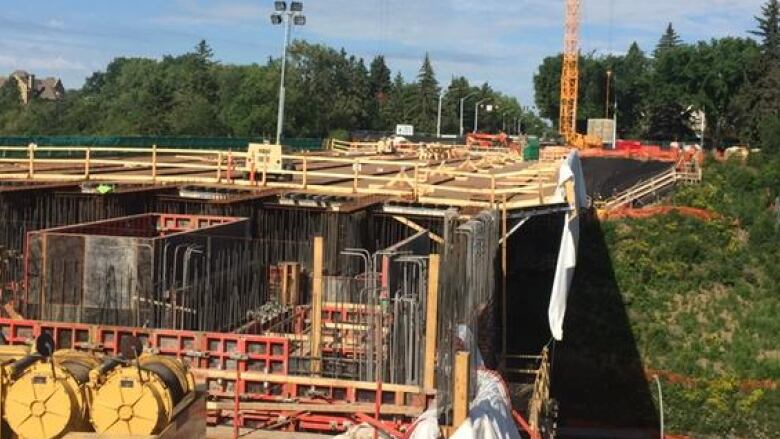Buckled girders over Groat Road weren't properly braced
Subcontractor failed to follow engineering plans, says city manager of road design

Three girders on the bridge over Groat Road buckled in March because the subcontractor hired to install them "misinterpreted" the bracing requirements in the engineering plans, the city says.
The subcontractor, hired by Graham Group, has 40 years experience in the field and is considered an industry leader, said Barry Belcourt, the city's branch manager of road design and construction.
The girders buckled at around 2:15 a.m. on March 16 while they were being installed on the 102nd Avenue bridge.
"There shouldn't be a lot of room for misinterpretation, but in the end that's what it was," Belcourt said. "The proper sequencing and the proper bracing at the right time wasn't followed to the 100th percentile, and therefore we had a failure."
The engineering drawings specified exactly the number of permanent and temporary braces needed to hold the seven massive girders in place after the crane released them, he said.
"You can have temporary bracing in place, but you still have to have the cranes doing the supporting," he said. "Temporary bracing will not hold it 100 per cent on its own. Thus, the failure."
The subcontractor submitted a plan to install the girders. The project engineer and engineers from Graham Group signed off on that plan, Belcourt said.
"There would have been multiple eyes approving that. At the end of the day, though, it wasn't followed."
"The spacing braces failed upon the crane release of the second-last girder," he said. "When the crane let go of the second-last girder it didn't happen right away, but basically that was the root cause of the buckling."
When the city first learned the extent of the damage, it was thought the buckled girders might have to be replaced by new ones. A team of engineers and consultants agreed that none of the girders would be used unless safety and integrity could be guaranteed.
In the end, crews removed the girders and used heat to straighten the steel.
Engineers signed off on the repairs and the three straightened girders were re-installed in late May.
The project contract called for a completion date of Sept. 30, 2015. For every day beyond that, the contractor is required to pay the city $11,500 in penalties. A delay of full year could add up to almost $4.2 million.
The city now says the bridge is scheduled to open in late summer or early fall of 2016.












_(720p).jpg)


 OFFICIAL HD MUSIC VIDEO.jpg)
.jpg)



























































































